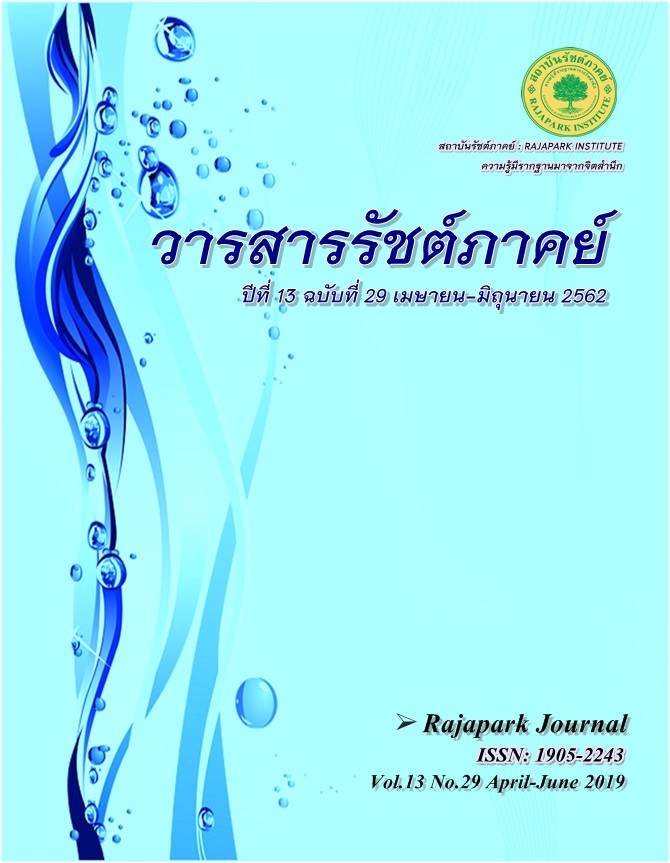Development Strategies of Rajapark Institute to Learning Organization
Main Article Content
Abstract
The purposes of this mixed method research were to 1) study the factors involved in the development of Rajapark Institute to the learning organization and 2) present the development strategy of Rajapark Institute to the learning organization. Tools used to collect data were questionnaires and interview forms. The sample group used in the study was 94 administrators and personnel including interviewing ten executives, teachers and stakeholders. The statistics including Mean, Standard deviation, and content analysis were applied to analyze data. The research found that 1) Factors related to the development of Rajapark Institute to the learning organization consist of structural factors, leadership, strategy, vision, mission, organizational culture information technology, performance development, and good management 2) Strategies for developing Rajapark Institute to a learning organization consist of five core strategies as follows: 1) development of Rajapark Institute to facilitate learning organization, 2) promotion of the use of knowledge management system to be implemented in Rajapark Institute in Rajapark Institute, 3) encouraging learning in operation and working with networks for learning exchange, 4) continuous development of personnel performance for readiness for change and sustainable development of Rajapark Institute, and 5) the development of information systems to be efficient, conducive to being a learning organization. 3) The assessment of the development strategy of Rajapark Institute to the learning organization by experts found to be appropriate, feasible, and beneficial at a high level.
Article Details

This work is licensed under a Creative Commons Attribution-NonCommercial-NoDerivatives 4.0 International License.
Views and opinions appearing in the Journal it is the responsibility of the author of the article, and does not constitute the view and responsibility of the editorial team.
References
Akkawong, S. (2014). Strategy Development for Learning Organization of Subdistrict Administrative Organization in Kamphaeng Phet Province. Journal of Education, Naresuan University, 16(1), 24-38.
Arunwet, T. (2014). Guideline for Education Improvement of Educational Institution. Retrieved February 10, 2015, from https://www.obec.to.th/news/48120
Beeby, M. & Booth, C. (2000). Networks and inter-organizational learning: a critical review. The Learning Organization, 7(2), 75-88.
Boonkerd, T. (2012). The guidelines for the development of a knowledge management systems and information technology management for knowledge management of Rangsit University. Rangsit Journal of Information Technology, 18(2), 36-61.
Chuphawa, R. (2013). Development of Learning Organization Model for Vocational Private Schools. Master of Education Program, Mahasarakham University.
Garvin. (2000). Learning in Action. Boston: Harvard Business School Press.
Kaiser, S. M. (2000). Mapping the Learning Organization: Exploring a Model of Organization Learning. Dissertation for the Degree of Doctor of Philosophy of the Louisiana University.
Peddler, M., Burgoyne, J., & Boydell, T. (1991). The Learning Company: A Strategy for Sustainable Development. New York: McGraw-Hill.
Rattanakoch, S. (2016). Development of Learning Organization of Higher Education Institutions. Academic Service Journal, Prince of Songkla University, 27(1), 144-150.
Sattachatramongkol, N. & Thammapaiboon, A. (2015). A study on factors affecting the learning organization of the private university. Business Review, Huachiew Chalermprakiet University, 7(1), 167-185.
Strategic Plan of Rajapark Institute. (2014). Academic Affairs, Rajapark Institute.
Vatjanasarikakul, L. (2014). Development of a Causal Relationship Model of Factors Influencing Learning Organization of Colleges under Office of the Vocational Education Commission. Doctor of Philosophy in Education, Department of Educational Administration, Valaya Alongkorn Rajabhat University.
Yupan, N., Traiwechit, T., & Intrasingathong, W. (2018). Motivation, Organizational Culture, Learning Organization, and Private School Effectiveness: Path Analysis. Humanities and Social Science, Journal of Graduate School, Pibulsongkram Rajabhat University, 12(1), 249-259.


